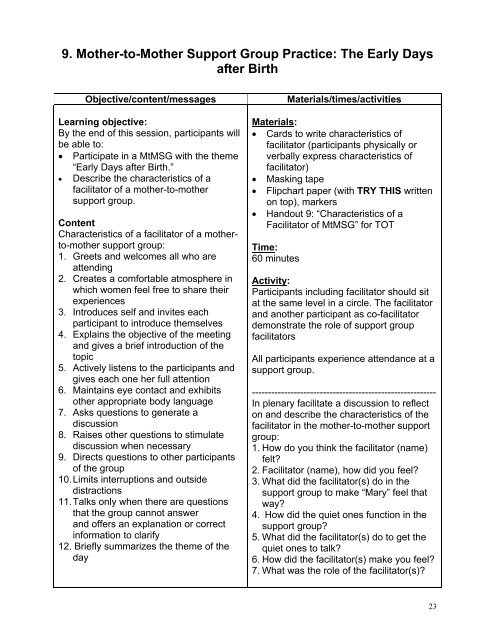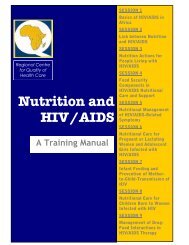Training of Trainers for Mother-to-Mother Support ... - Linkages Project
Training of Trainers for Mother-to-Mother Support ... - Linkages Project
Training of Trainers for Mother-to-Mother Support ... - Linkages Project
- No tags were found...
Create successful ePaper yourself
Turn your PDF publications into a flip-book with our unique Google optimized e-Paper software.
9. <strong>Mother</strong>-<strong>to</strong>-<strong>Mother</strong> <strong>Support</strong> Group Practice: The Early Days<br />
after Birth<br />
Objective/content/messages<br />
Learning objective:<br />
By the end <strong>of</strong> this session, participants will<br />
be able <strong>to</strong>:<br />
• Participate in a MtMSG with the theme<br />
“Early Days after Birth.”<br />
• Describe the characteristics <strong>of</strong> a<br />
facilita<strong>to</strong>r <strong>of</strong> a mother-<strong>to</strong>-mother<br />
support group.<br />
Content<br />
Characteristics <strong>of</strong> a facilita<strong>to</strong>r <strong>of</strong> a mother<strong>to</strong>-mother<br />
support group:<br />
1. Greets and welcomes all who are<br />
attending<br />
2. Creates a com<strong>for</strong>table atmosphere in<br />
which women feel free <strong>to</strong> share their<br />
experiences<br />
3. Introduces self and invites each<br />
participant <strong>to</strong> introduce themselves<br />
4. Explains the objective <strong>of</strong> the meeting<br />
and gives a brief introduction <strong>of</strong> the<br />
<strong>to</strong>pic<br />
5. Actively listens <strong>to</strong> the participants and<br />
gives each one her full attention<br />
6. Maintains eye contact and exhibits<br />
other appropriate body language<br />
7. Asks questions <strong>to</strong> generate a<br />
discussion<br />
8. Raises other questions <strong>to</strong> stimulate<br />
discussion when necessary<br />
9. Directs questions <strong>to</strong> other participants<br />
<strong>of</strong> the group<br />
10. Limits interruptions and outside<br />
distractions<br />
11. Talks only when there are questions<br />
that the group cannot answer<br />
and <strong>of</strong>fers an explanation or correct<br />
in<strong>for</strong>mation <strong>to</strong> clarify<br />
12. Briefly summarizes the theme <strong>of</strong> the<br />
day<br />
Materials/times/activities<br />
Materials:<br />
• Cards <strong>to</strong> write characteristics <strong>of</strong><br />
facilita<strong>to</strong>r (participants physically or<br />
verbally express characteristics <strong>of</strong><br />
facilita<strong>to</strong>r)<br />
• Masking tape<br />
• Flipchart paper (with TRY THIS written<br />
on <strong>to</strong>p), markers<br />
• Handout 9: “Characteristics <strong>of</strong> a<br />
Facilita<strong>to</strong>r <strong>of</strong> MtMSG” <strong>for</strong> TOT<br />
Time:<br />
60 minutes<br />
Activity:<br />
Participants including facilita<strong>to</strong>r should sit<br />
at the same level in a circle. The facilita<strong>to</strong>r<br />
and another participant as co-facilita<strong>to</strong>r<br />
demonstrate the role <strong>of</strong> support group<br />
facilita<strong>to</strong>rs<br />
All participants experience attendance at a<br />
support group.<br />
---------------------------------------------------------<br />
In plenary facilitate a discussion <strong>to</strong> reflect<br />
on and describe the characteristics <strong>of</strong> the<br />
facilita<strong>to</strong>r in the mother-<strong>to</strong>-mother support<br />
group:<br />
1. How do you think the facilita<strong>to</strong>r (name)<br />
felt<br />
2. Facilita<strong>to</strong>r (name), how did you feel<br />
3. What did the facilita<strong>to</strong>r(s) do in the<br />
support group <strong>to</strong> make “Mary” feel that<br />
way<br />
4. How did the quiet ones function in the<br />
support group<br />
5. What did the facilita<strong>to</strong>r(s) do <strong>to</strong> get the<br />
quiet ones <strong>to</strong> talk<br />
6. How did the facilita<strong>to</strong>r(s) make you feel<br />
7. What was the role <strong>of</strong> the facilita<strong>to</strong>r(s)<br />
23
















